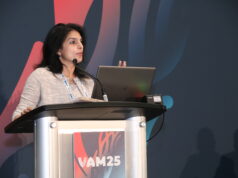
Michael S. Conte, MD, one of the foremost experts in the field of peripheral arterial disease (PAD), took attendees of the 2023 annual meeting of the Society for Clinical Vascular Surgery (SCVS) in Miami on a journey through the decades of evidence-based revascularization for limb-threatening ischemia, telling those gathered that the recently published “landmark” BEST-CLI trial evidence should lead to a shift in the current practice landscape where open bypass surgery is “under-offered and under-utilized.”
Conte, chair, professor and chief of vascular and endovascular surgery at the University of California San Francisco (UCSF), was delivering the SCVS 2023 (March 25–29) Distinguished Visiting Professor address, devoting a significant portion to the recent publication of the BEST-CLI (Best endovascular versus best surgical therapy for patients with CLTI) randomized-controlled trial (RCT) data, and what its results means for the treatment of chronic limb-threatening ischemia (CLTI) going forward.
Conte posed the ultimate question: What are the take-home messages in the world of CLTI treatment post-publication of the BEST-CLI results. “I think it is really clear,” said Conte. “That an endo[vascular]-first, or, even more strikingly, endo-only approach, to all patients with CLTI is simply not evidence-based care. And Centers of Excellence must be skilled in both techniques of revascularization.
“Furthermore, informed decision-making with patients in this field should include the results of this evidence, and suitable patients should be offered the option of open bypass surgery, which I suspect is being under-offered and under-utilized in current practice. I think this trial should make that begin to change.
“It’s not surprising—it shouldn’t be surprising to us—that there are trade-offs between effectiveness and invasiveness. This is common in medicine and surgery, and, as I showed you, it is common in coronary artery disease. We need to embrace it and accept it. But I would suggest to you that one of the differences between coronary disease and vascular disease is that, as vascular surgeons doing both of these things, we have the opportunity to make these decisions. That could be either an advantage or burden, because we all have settled into our ways and our workflows, and maybe unwilling to change what we currently do in practice.”
Conte then returned to an overarching message he also delivered at a BEST-CLI session hosted at the 2022 VEITHsymposium that took place in New York in November. “I would suggest to you that centers doing less than 20% bypass in CLTI should really probably take stock about whether this is the best treatment for these patients,” he said.
Results from BEST-CLI showed that surgical bypass with adequate single-segment great saphenous vein (GSV) is a more effective revascularization strategy for patients with chronic limb-threatening ischemia (CLTI) who are deemed to be suitable for either an open or endovascular approach, the investigators reported. In patients without a suitable single-segment saphenous vein, both surgical and endovascular strategies were found to be effective in treating patients with CLTI, leading the investigators to conclude that there is “a complementary role for both revascularization strategies in these patients.”
BEST-CLI was a “landmark effort by [principal investigators] Alik Farber, Matt Menard and many others,” he said. Their passion and dedication “cannot be overstated in making this a reality over almost a decade, with much more to come from this trial.”
The work exhibited vascular surgeons taking the lead, he continued, “designing and executing science that is practice-changing science,” and “that needs to be recognized,” Conte added. It involved the BEST-CLI researchers taking lessons learned over the 20- to 30-year time span covering the development of evidence-based revascularization that he outlined in his address, he said, rolling them into the design of the trial.
Conte, having summarized BEST-CLI’s headline results and delved into characteristics of its two cohorts to underscore his point, also noted the trial’s limitations—a theme of focus among its skeptics. “Any trial can only begin to answer certain questions, and raises many others,” he said. “I think it is currently the standard, landmark trial in our field from which we can launch forward with true evidence-based guidelines and approaches.”











